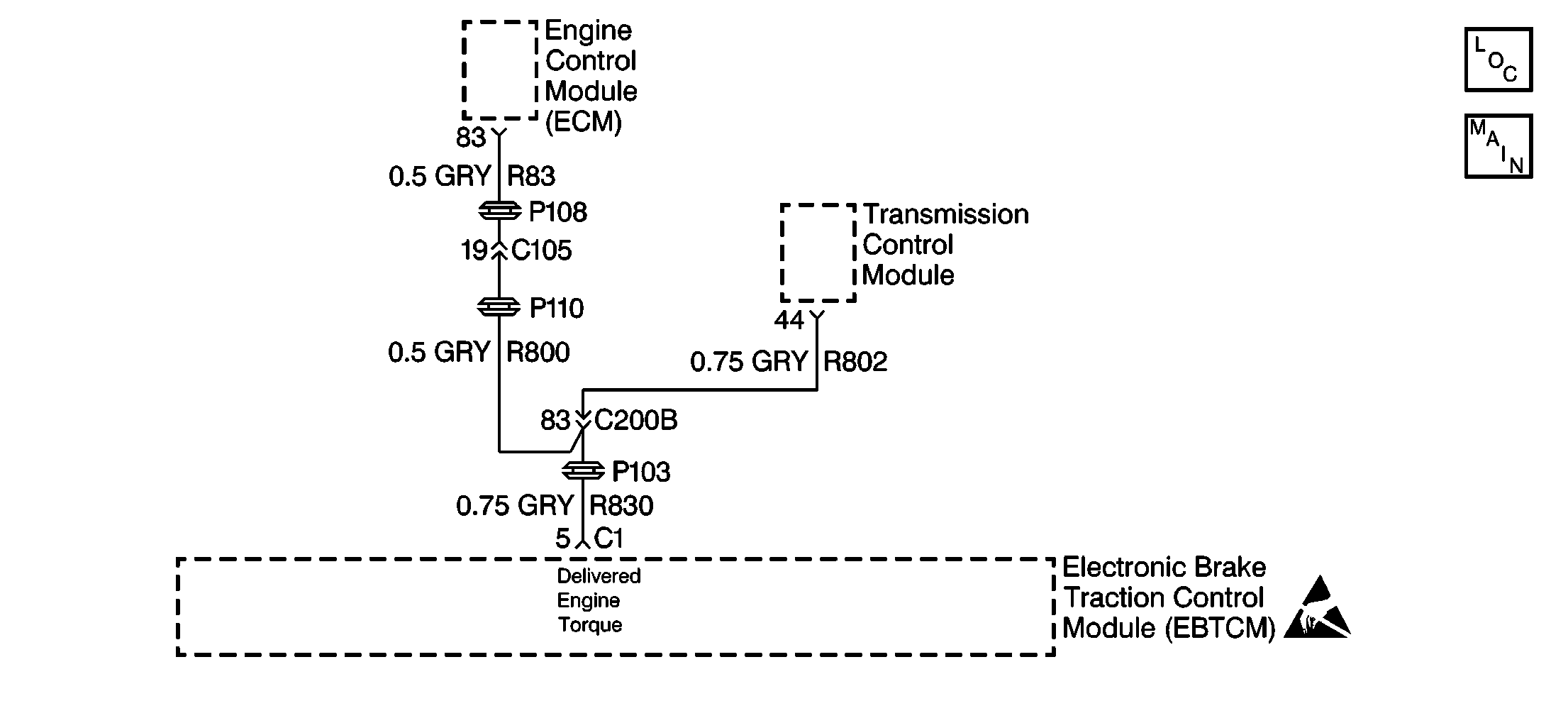
Circuit Description
The traction control system uses the ECM fuel controls and uses the ignition controls to limit drive wheel slippage during acceleration. The ECM reduces engine torque by retarding spark timing, and/or shutting off up to three injectors. The EBTCM sends a torque request to the ECM via a Pulse Width Modulated (PWM) signal requesting the desired torque level for proper traction control system operation. The ECM then provides a delivered torque PWM signal informing the EBTCM how much actual torque is produced by the engine.
Conditions for Setting the DTC
| • | After initialization and after 2 seconds have past, the EBTCM does not receive a minimum of 2 signals within 100 milliseconds of each other. |
| • | There is an open in the circuit. |
| • | There is a short to ground in the circuit. |
| • | There is a short to voltage in the circuit. |
Action Taken When the DTC Sets
| • | A malfunction DTC is stored. |
| • | The TC indicator lamp is turned on. |
| • | The TCS is disabled. |
| • | The ABS remains functional. |
Conditions for Clearing the DTC
| • | The condition for the DTC is no longer present. |
| • | The scan tool Clear DTCs function is used. |
| • | 100 drive cycles have passed with no DTCs detected. |
Diagnostic Aids
The following can cause an intermittent malfunction:
| • | A poor connection may cause an intermittent malfunction. |
| • | Rubbed through wire insulation may cause an intermittent malfunction. |
| • | A wire that is broken inside the insulation may cause an intermittent malfunction. |
Check for the following in any circuit suspected of causing an intermittent malfunction:
| • | Check for backed out terminals. |
| • | Check for improper mating. |
| • | Check for broken locks. |
| • | Check for improperly formed terminals. |
| • | Check for damaged terminals. |
| • | Check for poor terminal to wiring connections. |
| • | Check for physical damage to the wiring harness. |
Perform a thorough inspection of the wiring. Perform a thorough inspection of the connectors. Failure to carefully and fully inspect the wiring and the connectors may result in misdiagnosis. Misdiagnosis causes part replacement with reappearance of the malfunction.
Test Description
The number(s) below refer to the step number(s) on the diagnostic table.
-
It is very important to check ground G103. Corrosion or a loose connection at this point may cause a malfunction in the PWM signal.
-
The scan tool can be used to check the delivered engine torque signal from the Engine Control Module. It should fluctuate up and down with throttle movement.
-
This test checks the presents of a pull-up voltage from the EBTCM.
Step | Action | Value(s) | Yes | No | ||||||||||||||||||||||||||||||||||||||||||||
|---|---|---|---|---|---|---|---|---|---|---|---|---|---|---|---|---|---|---|---|---|---|---|---|---|---|---|---|---|---|---|---|---|---|---|---|---|---|---|---|---|---|---|---|---|---|---|---|---|
1 | Was the Diagnostic System Check performed? | -- | Go to A Diagnostic System Check | |||||||||||||||||||||||||||||||||||||||||||||
Check that ground G103 is clean and check that ground G103 is torqued to the proper specifications. Refer to Ground Distribution in Wiring Systems for ground specifications and ground locations. Are the following signs evident:
| -- | |||||||||||||||||||||||||||||||||||||||||||||||
Did the percent of delivered torque fluctuate within the specified range? | 20-60 % | |||||||||||||||||||||||||||||||||||||||||||||||
Is the voltage measured equal to or greater than the specified voltage? | 10 V | |||||||||||||||||||||||||||||||||||||||||||||||
5 |
Is the voltage measured within the specified range? | 0-2 V | ||||||||||||||||||||||||||||||||||||||||||||||
6 |
Are the following signs evident:
| -- | ||||||||||||||||||||||||||||||||||||||||||||||
7 |
Is the resistance within the specified range? | 0-2 ohms | ||||||||||||||||||||||||||||||||||||||||||||||
8 | Use a J 39200 DMM to measure the resistance between the J 39700 terminal 5 and ground. Is the resistance within the specified range? | OL (Infinite) | ||||||||||||||||||||||||||||||||||||||||||||||
9 |
Are the following signs evident:
| -- | ||||||||||||||||||||||||||||||||||||||||||||||
10 |
Did DTC 66 reset? | -- | ||||||||||||||||||||||||||||||||||||||||||||||
11 |
Did DTC 66 reset? | -- | ||||||||||||||||||||||||||||||||||||||||||||||
12 | Repair the short to voltage in the delivered engine torque circuit. Refer to Wiring Repairs in Wiring Systems. Is the repair complete? | -- | Go to A Diagnostic System Check | -- | ||||||||||||||||||||||||||||||||||||||||||||
13 | Repair an open or repair a high resistance in the delivered engine torque circuit. Refer to Wiring Repairs in Wiring Systems. Is the repair complete? | -- | Go to A Diagnostic System Check | -- | ||||||||||||||||||||||||||||||||||||||||||||
14 | Repair a short to ground in the delivered engine torque circuit. Refer to Wiring Repairs in Wiring Systems. Is the repair complete? | -- | Go to A Diagnostic System Check | -- | ||||||||||||||||||||||||||||||||||||||||||||
15 | Replace all the terminals or replace the connectors that exhibit signs of the following:
Refer to Connector Repairs or Repairing Connector Terminals in Wiring Systems. Is the repair complete? | -- | Go to A Diagnostic System Check | -- | ||||||||||||||||||||||||||||||||||||||||||||
16 | Suspect ECM. Refer to Powertrain On Board Diagnostic (OBD) System Check in Engine Controls. Is the diagnosis complete? | -- | Go to A Diagnostic System Check | -- | ||||||||||||||||||||||||||||||||||||||||||||
17 | The malfunction is intermittent or the malfunction is not present at this time. Refer to Diagnostic Aids for more information. Is the diagnosis complete? | -- | Go to A Diagnostic System Check | -- | ||||||||||||||||||||||||||||||||||||||||||||
18 | Repair the ground as necessary. Refer to Wiring Repairs in Wiring Systems if the ground terminal requires replacement. Is the repair complete? | -- | Go to A Diagnostic System Check | -- | ||||||||||||||||||||||||||||||||||||||||||||
19 | Replace the EBTCM. Refer to EBTCM Replacement . Is the repair complete? | -- | Go to A Diagnostic System Check | -- |
